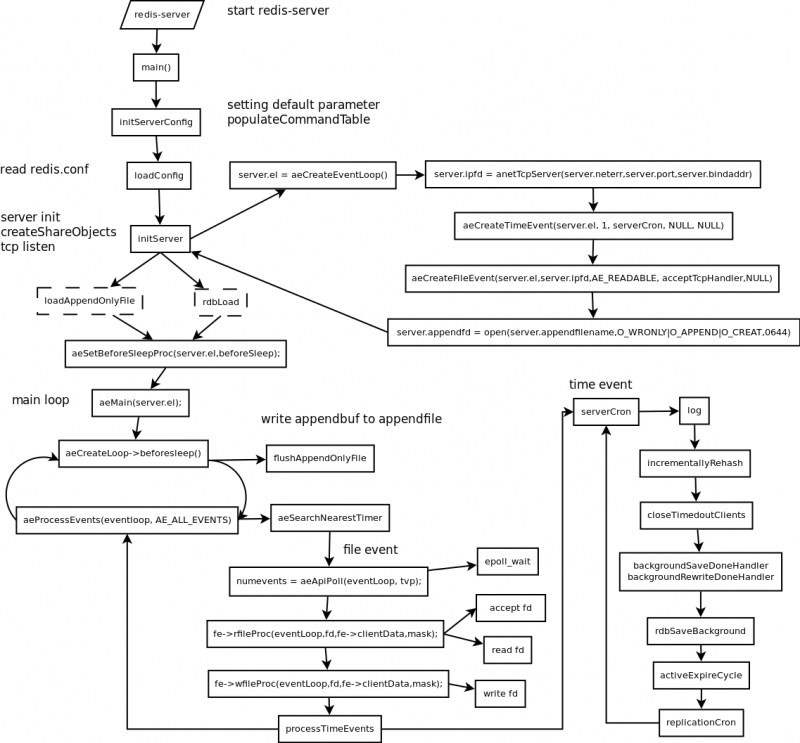Redis 基本搭建
链接:http://blog.itpub.net/28602568/viewspace-2120239/
标题:Redis 基本搭建
作者:lōττéry©版权所有[文章允许转载,但必须以链接方式注明源地址,否则追究法律责任.]
前言:
Redis是一个基于内存的高性能key-value数据库,数据都保存在内存中定期刷新到磁盘,以极高的读写效率而备受关注。
他的特点是支持各种数据结构,stirng,hashes, list,set,和sorted sets client端对于不同数据结构是使用不同的命令。
Redis服务器的daemon启动程序
redis-cli是Redis的客户端工具。关于redis-cl命令的参数说明见下表
redis-benchmark是Redis的性能测试工具
redis-check-dump dump.rdb 检查本地数据文件
redis-check-aof appendonly.aof 更新日志检查 ,加--fix参数为修复log文件
Redis 主要程序流程

安装步骤:
wget http://download.redis.io/redis-stable.tar.gz ---3.2.0版本
tar xvzf redis-stable.tar.gz
cd redis-stable
make
ps -ef|grep redis ---查看redis进程是否有启动
cp -p src/redis-server /usr/local/bin/
cp -p src/redis-cli /usr/local/bin/
将redis.conf文件的daemonize参数改为yes,redis改为后台启动
[root@localhost redis-stable]# grep daemonize redis.conf |grep -v "^#"
daemonize yes
[root@localhost redis-stable]# redis-server redis.conf --port 7777 /*默认端口6379,可通过redis-server --port更改端口*/
[root@localhost redis-stable]# ps -ef |grep redis|grep -v grep
root 20165 1 0 16:12 ? 00:00:00 redis-server 127.0.0.1:7777
[root@localhost redis-stable]#
设置key --- set key和get key
[root@localhost src]# redis-cli
127.0.0.1:7777> ping
PONG
127.0.0.1:7777> set mykey somevalue
OK
127.0.0.1:7777> get mykey
"somevalue"
127.0.0.1:7777>
查看版本:
[root@localhost src]# redis-cli --version
redis-cli 3.2.0
[root@localhost src]# redis-server --version
Redis server v=3.2.0 sha=00000000:0 malloc=jemalloc-4.0.3 bits=64 build=47622ff85e6ad599
[root@localhost src]#
[root@localhost redis-stable]# redis-cli --help
redis-cli 3.2.0
Usage: redis-cli [OPTIONS] [cmd [arg [arg ...]]]
-h Server hostname (default: 127.0.0.1).
-p Server port (default: 6379).
-s Server socket (overrides hostname and port).
-a Password to use when connecting to the server.
-r Execute specified command N times.
-i When -r is used, waits seconds per command.
It is possible to specify sub-second times like -i 0.1.
-n Database number.
-x Read last argument from STDIN.
-d Multi-bulk delimiter in for raw formatting (default: /n).
-c Enable cluster mode (follow -ASK and -MOVED redirections).
--raw Use raw formatting for replies (default when STDOUT is
not a tty).
--no-raw Force formatted output even when STDOUT is not a tty.
--csv Output in CSV format.
--stat Print rolling stats about server: mem, clients, ...
--latency Enter a special mode continuously sampling latency.
--latency-history Like --latency but tracking latency changes over time.
Default time interval is 15 sec. Change it using -i.
--latency-dist Shows latency as a spectrum, requires xterm 256 colors.
Default time interval is 1 sec. Change it using -i.
--lru-test Simulate a cache workload with an 80-20 distribution.
--slave Simulate a slave showing commands received from the master.
--rdb Transfer an RDB dump from remote server to local file.
--pipe Transfer raw Redis protocol from stdin to server.
--pipe-timeout In --pipe mode, abort with error if after sending all data.
no reply is received within seconds.
Default timeout: 30. Use 0 to wait forever.
--bigkeys Sample Redis keys looking for big keys.
--scan List all keys using the SCAN command.
--pattern Useful with --scan to specify a SCAN pattern.
--intrinsic-latency Run a test to measure intrinsic system latency.
The test will run for the specified amount of seconds.
--eval Send an EVAL command using the Lua script at .
--ldb Used with --eval enable the Redis Lua debugger.
--ldb-sync-mode Like --ldb but uses the synchronous Lua debugger, in
this mode the server is blocked and script changes are
are not rolled back from the server memory.
--help Output this help and exit.
--version Output version and exit.
Examples:
cat /etc/passwd | redis-cli -x set mypasswd
redis-cli get mypasswd
redis-cli -r 100 lpush mylist x
redis-cli -r 100 -i 1 info | grep used_memory_human:
redis-cli --eval myscript.lua key1 key2 , arg1 arg2 arg3
redis-cli --scan --pattern '*:12345*'
(Note: when using --eval the comma separates KEYS[] from ARGV[] items)
When no command is given, redis-cli starts in interactive mode.
Type "help" in interactive mode for information on available commands
and settings.
[root@localhost redis-stable]#
正文到此结束
热门推荐
相关文章
Loading...











![[HBLOG]公众号](https://www.liuhaihua.cn/img/qrcode_gzh.jpg)

